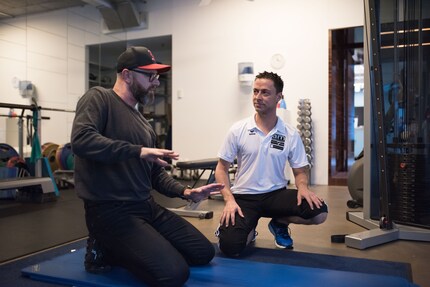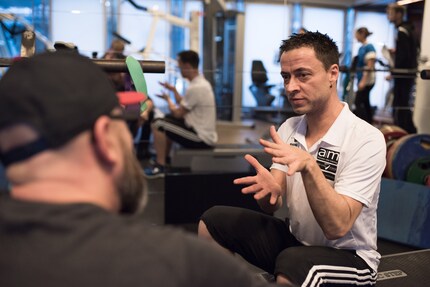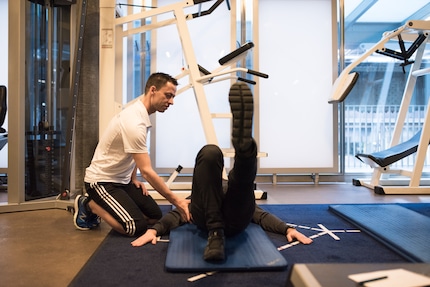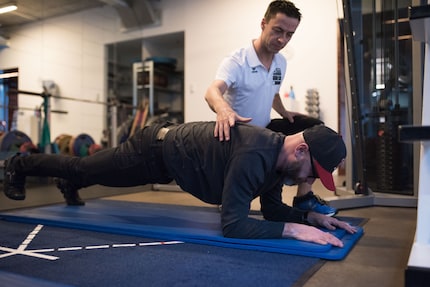
Product test
Wired up for a six-pack week #5 and #6
by Patrick Bardelli

How good is electrical muscle stimulation EMS? The manufacturers of these products are making big promises. But can they keep them?
A six-pack in six weeks with a little help from electrical muscle stimulation. Does that work? This summer, I regularly stimulated my abs with the Compex «SP 8.0 WOD Edition». The result is disappointing. My belly looks pretty much the same as it did before I started using the Compex. Here’s my verdict on it:
So are manufacturers of these devices promising too much? Yes and no, says Thilo Bönsel – Physiotherapist BSc and deputy head of physiotherapy at am physio at SportClinic Zurich. He works at the clinic’s branch at «Puls 5», where he occasionally uses electrical muscle stimulation by Compex.
When do you apply this type of treatment?
Thilo Bönsel, physiotherapist: We mainly use Compex EMS on patients who have just had surgery. These are patients who were immobilised by the operation and were not allowed to strain a certain muscle group. They might have had a cartilage operation, for example, after which they should not put any weight on the cartilage.
What effect does electrical muscle stimulation have in such a case?
We want to prevent post-operative muscle degradation. Although there is no way of completely preventing this, Compex devices definitely help minimise this negative effect.
I’m currently suffering from muscular back pain. Why aren’t you using EMS on me? After all, Compex even have suitable features.
Many studies have been conducted on back problems. They have shown that so-called EMS suits, which are full bodysuits, are more effective than smaller devices that only focus on one or two muscle groups. The suits are better at activating and stimulating deep muscles. What’s also important in this context is combining the suit with active workouts. In other words, a mix of wearing the suit and exercising your abdominal and back muscles has the biggest effect. Meanwhile, Zurich also has a few fitness studios that specialise in EMS suit workouts.
If you wanted to achieve the same effect as the suit does, you’d need to splash out on several small devices. However, in Thilo Bönsel’s opinion, it is questionable whether health insurances would cover the costs for several devices, let alone this relatively new type of suit therapy.
For my back this means going through classic physiotherapy in combination with various exercises to strenghten my abs and back muscles. A combination that works quite well, I might add. That’s provided you’re doing the exercises correctly.


Let’s ignore the money factor and talk about my self-test to get a six-pack in six weeks. Any thoughts?
You activated your muscles because the electrical stimulus was tensing them. However, what was missing was a combination with actual physical exercises. To put it another way, you can’t just stick the pads on your belly, watch TV for thirty minutes and expect a six-pack to appear.
In your experience, what would I have to do to get a defined six-pack?
Your main focus would have to be on your diet. And naturally, targeted training units would also be a must. Having said that, building good abs requires a lot of patience and discipline. We’re talking several months. Particularly when it comes to dieting, people with six-packs tend to be incredibly strict. There’s no way around it. Unfortunately (he laughs).
So EMS is no replacement for physical training?
No, it’s not. Without the exercising units, you’ve just got passive tension; so-called isometric tension of the muscles. But there’s not dynamic effect. Our muscles are made for physical dynamics; so moving and stabilising joints. This means that physical exercise also always works other structures – tendons and ligaments, for example. Passive electrical stimulation does not come with these effects.
So combining a workout and EMS is ideal?
That’s right.
I ask Thilo if the effects of a workout with a Compex can be quantified. Thilo Bönsel says there have been some studies on this. Once again, they revealed that EMS suits are somewhat more effective than using just one device. To give you an example, this is because a suit simultaneously covers the front and back hamstrings as well as your buttocks and core.
«After six to eight weeks of training in an EMS suit, a strength increase becomes visible. This was also noticable when compared to control groups who trained without electrical muscle stimulation. For the latter, the increase was smaller.»
However, this effect only set in around two weeks before the end of the test phase.
How come?
It seems that training with an EMS suit puts a lot more strain on the body than without. It is also more strenuous than working out with just one device. Adding the suit seems to destroy more muscle structures. Structures that the body has to repair before additional effects becomes visible. This benefit was also seen in both maximum strength as well as for speed. Something that can be very interesting for, let’s say, pro footballers. It allows them to squeeze that bit more performance out during training.


Let’s forget the suits for now: Are there other areas of use for the Compex SP 8.0?
We haven’t spoken about regeneration yet. This is an area that can greatly benefit from electrical muscle stimulation. Especially for athletes who don’t have the opportunity to get a massage or see a physiotherapist after training, this can be a good alternative. The respective regeneration programmes relax the muscles and stimulate both metabolism and regeneration processes.
What’s your verdict of the Compex SP 8.0?
Personally, I think the device is good for targeting individual muscle groups after an operation. It slows down muscle degradation and promotes regeneration after intense physical units. But when it comes to aesthetics, i.e. muscle gain, I’m sceptical. The device is definitely no replacement for a training session. By contrast, the EMS suit we spoke about is definitely beneficial when used during workouts.
View the full Compex range at Galaxus here. Want to follow me? Then click here.
From radio journalist to product tester and storyteller, jogger to gravel bike novice and fitness enthusiast with barbells and dumbbells. I'm excited to see where the journey'll take me next.